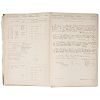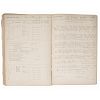USRC Bear Log Books Under the Direction of Captain Michael A. Healy, One Documenting the Important 1892 Season, Set of Eight
About Seller
6270 Este Ave.
Cincinnati , OH 45232
United States
With offices in Cincinnati, Cleveland and Denver, Cowan’s holds over 40 auctions each year, with annual sales exceeding $16M. We reach buyers around the globe, and take pride in our reputation for integrity, customer service and great results. A full-service house, Cowan’s Auctions specializes in Am...Read more
Two ways to bid:
- Leave a max absentee bid and the platform will bid on your behalf up to your maximum bid during the live auction.
- Bid live during the auction and your bids will be submitted real-time to the auctioneer.
Bid Increments
| Price | Bid Increment |
|---|---|
| $0 | $25 |
| $500 | $50 |
| $1,000 | $100 |
| $2,000 | $250 |
| $5,000 | $500 |
| $10,000 | $1,000 |
| $20,000 | $2,500 |
| $50,000 | $5,000 |
| $100,000 | $10,000 |
About Auction
Feb 21, 2017 - Feb 22, 2017
Cowan's Auctions dawnie@cowans.com
- Lot Description
Set of 8 log books, each measuring 11 x 17 in. and weighing approximately 10 pounds for the US Revenue Cutter Service's (now the US Coast Guard) most famous ship, the USRC Bear. In total, there are approximately 374 completed pages in each book, with a daily entry on two special preprinted pages. The left side is for technical log entries for wind, barometer, course, hourly sailing headings/bearings, etc. The right portion records miscellaneous events of the day penned by a ship's officer, many signed off by Captain Michael A. Healy.
Born to Michael Morris Healy, an Irish immigrant planter, and Mary Eliza Smith, his common-law wife, a mixed race, African American slave, Michael Healy was the fifth of their ten children. Healy and his siblings were all born into slavery, but several earned high-ranking positions never before attained by a person of African American descent. When he was sixteen, Healy ran away to become a seaman. Like his siblings, 19th century notions of race and his light complexion allowed him to live and work as a white man. He rose through the ranks and eventually earned the command of the USRC Bear.
Originally built as a whaling ship, the Bear became the best-known vessel in the US Revenue Cutter Service. She first gained national notoriety while being a part of the rescue for the Greely Expedition in the Antarctic. The Bear's log books offered in the lot cover her service from May 5, 1889 until November 12, 1889; June 9, 1889 until October 31, 1890; March 31, 1891 until September 30, 1891; April 28, 1892 until October 31, 1892; May 2, 1893 until November 12, 1893; April 21, 1894 until September 30, 1894; May 1, 1897 until November 6, 1897, under the direction of Captain Tuttle; and November 7, 1897 until May 3, 1899, also under Tuttle.
The crew looked out for seal poachers, shipwrecked whalers, and illicit trade with Native Alaskans. All entries detail her daily workings including navigating through icy waters; dodging heavy blocks of ice; communicating with natives in canoes and kayaks; transporting non-native reindeer; and boarding American whaling ships such as the Orca, Beluga, Newport, and Sea Breeze. In the book dating from April 28, 1892 until October 31, 1892, few excerpts of note include:
Stopping a successful smuggler (May 2); confining a drunken seaman in irons (May 8); interrogating an intoxicated Native Alaskan brought aboard ship who obtained liquor from the American whaling ship (June 8); boarding the suspected ship and discovering empty whiskey barrels (June 8); stopping and boarding whalers out of San Francisco; an accident involving the American whaler California caught in heavy ice (June 10); transporting crew of the wrecked Alexander to a safe destination (June 2); the ship's surgeon giving medical treatment and rations to Native Alaskans (June 15); and a comprehensive record of the catch of the Arctic whaling fleet season of 1892 with a complete summary of all 35 named American whale ships as well as the vessels lost and those that chose to winter. The entries are representative of the other log books included in the lot.
The 1892 season was very important to Alaskan history and to its environment. Troubled by starving Native Alaskans, Healy suggested to Dr. Sheldon Jackson that he should approach Congress and ask to support an initiative to introduce Siberian reindeer to Alaska. They hoped the reindeer would broaden the resource base, replenish the dwindling food supply, and Alaskan natives could profit and feed on reindeer like Siberian natives in Russia. Congress approved the motion, but did not allocate any funds for it. Jackson privately raised money and Healy contributed some of his own funds to purchase a test herd. After the first herd produced successful offspring, Healy began to deliver more reindeer to the area. The Reindeer Research Program writes that, “during the summer 1892, Captain Healy made five trips to Siberia and brought a total of 171 reindeer along with 5 Siberian herders, employed as herding instructors, to the Teller Reindeer Station established at Port Clarence” (Information obtained from the University of Alaska Fairbanks Website, December 5, 2016). The Bear’s log books record the transportation and establishment of reindeer populations in Alaska that summer. Some of the entries related to reindeer include:
...received on board 25 reindeer…and sent ashore for more; surgeon sent ashore to examine reindeer; by day’s end 53 reindeer aboard procured from local natives (July 2); erecting house for the reindeer station, signed by Healy (July 23); came to anchor off station…Employed landing 63 Reindeer (July 29); came to anchor in Siberia; vessel visited by natives (Aug 3); and sent cutter ashore for reindeer food (Aug 8).
Provenance: N. Flayderman and Co., Inc.All of the books' bindings and spines are in poor condition, some are worse than others. There is some surface wear of the covers. The papers remain intact and complete with legible handwriting and minor toning. Very few of the log books have loose pages. Information obtained from http://reindeer.salrm.uaf.edu/about_reindeer/history.php.Condition
- Shipping Info
-
SHIPPING. At the request of the buyer, Cowan's will authorize the shipment of purchased items. Shipments usually occur within two weeks after payment has been received. Shipment is generally made via UPS Ground service. Unless buyer gives special instructions, the shipping method shall be at the sole discretion of Cowan's Auctions, Inc.. Cowan's is in no way responsible for the acts or omissions of independent handlers, packers or shippers of purchased items or for any loss, damage or delay from the packing or shipping of any property.
-
- Buyer's Premium



 EUR
EUR CAD
CAD AUD
AUD GBP
GBP MXN
MXN HKD
HKD CNY
CNY MYR
MYR SEK
SEK SGD
SGD CHF
CHF THB
THB

















